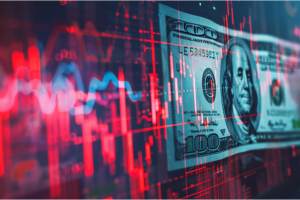
Sobering analysis from The Wall Street Journal … a direction 180 after four decades … today’s valuation problem … the good news buried in bad news … a free trading tool
The market environment has changed. If your market approach doesn’t change with it, your wealth, financial independence, and retirement are at risk.
This isn’t the most heartwarming way to begin a Digest, but it’s critical that investors embrace reality, no matter how unpleasant. We must recognize the multi-decade shift that’s occurred in the investment markets and gameplan our response.
To be clear, this isn’t a “gloom and doom” Digest.
The market environment we’ve entered can be incredibly lucrative. But that outcome requires us to accurately diagnose today’s “new normal” and adjust our investing strategy accordingly.
As we’ve stressed in recent Digests, this isn’t the same market that rewarded the buy-and-hold discipline of our grandparents and parents. With the gift of hindsight, we can see that they had the benefit of perhaps the most advantageous investing climate of all time.
That climate no longer exists.
Now, you’ve heard this from me in recent months. But if I couldn’t convince you, here’s The Wall Street Journal from yesterday:
Investors, we’re not in Kansas anymore.
For four decades, patient savers able to grit their teeth through bubbles, crashes and geopolitical upheaval won the money game.
But the formula of building a nest egg by rebalancing a standard mix of stocks and bonds isn’t going to work nearly as well as it has.
Now, longer-term Treasury yields have hit their highest levels in 16 years, causing their value to plummet, and stocks are expensive.
So, investors need to lower their expectations and play defense.
While we agree with the WSJ in general, we would change the final takeaway to “so, investors need to adjust their buy-and-hold expectations and learn to play better offense through opportunistic trading.”
What changed in the market, and what does it mean?
In a moment, we’ll dive into how to make money in this new market era. But before we get there, for newer Digest readers, let’s quickly recap what’s changed, and why it demands a different market approach.
In short, the 10-year Treasury yield has changed its cardinal direction after four decades.

Sure, there will be stretches of declines as the chart above shows. But today’s big macro forces point toward a new era of rising treasury yields.
As we’ve detailed many times here in the Digest, stocks don’t like high bond yields. There are two big reasons why.
From a valuation perspective, higher bond yields put upward pressure on the discount rate used to value a company’s stock. Given the math involved in this calculation, the higher the discount rate, the lower the net present value of future flows, and vice versa.
So, higher long-term bond yields – and by extension, a higher discount rate – are a drag on stock valuations.
From a competition perspective, the higher the yield of “risk free” government bonds (if held to maturity), the more it lures conservative investors away from stocks. This creates another downward pressure on stock prices as investors pull their money out of equities.
Looked at from the other direction, when bond yields are falling, it gooses stock valuations, and reduces the attractiveness of the bond market. This steers investors into stocks, further inflating prices.
This is what we enjoyed for four decades. And this is what the charts suggest is now a relic of yesteryear.
So, given the new trend, what does market history tell us about stock performance in such a market environment?
When the buy-and-hold 60/40 stock/bond portfolio failed
Before the great bull market began in the early 1980s, market performance was abysmal.
From 1962 through 1982, treasury bonds were in a bear market. As the price of the 10-year treasury bond cratered, yields spiked from less than 4% to more than 15%.
Let’s return to the WSJ for how this two-decade-long bear market impacted investor portfolio values:
In the mid-1960s, stock valuations were at their most expensive level in decades based on a cyclically adjusted formula devised by Nobel Prize-winning economist Robert Shiller. And stocks were pricey just as inflation began to take off.
The result: A family setting aside $1,000 for their toddler’s education at the end of 1965 in a 60/40 portfolio ended up with $785 in real terms by her senior year of high school in January 1982.
Things aren’t looking much better today.
Last year was one of the worst ever in real terms for a 60/40 portfolio, and the beatings could continue. Shiller’s valuation metric is still higher than it was in 1966.
Below, we look at Shiller’s valuation metric, the “CAPE” PE ratio, for more context (this CAPE measurement uses rolling 10-year average earnings to smooth out business cycle fluctuations). We’ve added a trendline from 1965’s CAPE level, showing you how it compares to today’s CAPE valuation.

If you’re having trouble seeing the chart, even after all the market pain we’ve experience since August, the S&P’s valuation remains higher than it was in the mid-1960s before its painful bear run that the WSJ just highlighted.
Back to the WSJ with a sobering statistic stemming from today’s valuation:
When stocks have been in the most-expensive quintile of valuations, as they are now, they have produced real annual returns over the following decade of just 2.7% on average.
So, investors could feel even more pain.
Even though this sounds unappealing so far, it doesn’t have to be all bad news
Below, we look at the S&P from 1965 through 1982. Not a great chart if you’re a buy-and-hold index investor…

But if you’re a nimble, opportunistic trader, here’s how this same chart appears…

Now, making money surely wasn’t as easy as I’m suggesting with these highlighted returns above.
But the point is that expecting a seesaw market – and approaching it with a trading mentality – provides investors the opportunity to capitalize on volatility, not be destroyed by it.
Friends, expect a seesaw market.
A new, free tool to help you on your trading journey
In recent Digests, we’ve put trading front-and-center as we try to help readers recognize today’s “new normal” and hone their trading chops.
To that end, we’ve waded into technical analysis, detailing the Relative Strength Index and MACD indicators, as well as basic chart patterns. We’ve also put several mean-reversion trades on your radar.
Today, let’s give you another fantastic – and free – trading resource.
TradeSmith is our corporate partner. It also happens to be one of the preeminent quantitative investment shops in the entire investment industry.
They have a free quantitative dashboard that can save you hours of research time as you search for your next trade.
Bookmark https://analytics.tradesmith.com/. It provides the following invaluable up-to-date market data:
- Most overbought sectors (based on RSI)
- Most oversold sectors (based on RSI)
- Top stocks in terms of Business Quality Score (BQS)
- Trinity Stocks
(TradeSmith defines a Trinity Stock as a high-quality business… trading at a reasonable valuation … that’s in an uptrend.)
- Stock performance leaders over the past month, 6 months, 52 weeks, and year to date
If you’re looking for mean-reversion rallies, momentum trades, or short trades based on stocks that have surged too high, too fast, this is a fantastic resource.
Finally, if you want to benefit from trading without investing the time to learn how to trade, we have you covered
I’ll quickly make you aware of InvestorPlace’s trading services.
From legendary investor Louis Navellier we have AI Advantage. It’s a cutting-edge AI system that predicts where fundamentally superior stocks will be trading 21 trading days into the future with 82% accuracy. Its goal is consistent, short-term trading profits that “stack” over time.
From our hypergrowth expert Luke Lango, we have AI Trader . It relies on Luke’s proprietary AI platform “Prometheus” that’s designed and engineered to find stocks returning double-or triple-digits before they begin such a rally. Its trades typically run a handful of months or quarters.
Finally, there’s our macro expert, Eric Fry, with his longer-term trading service, The Speculator. Eric often uses LEAPS (Long-Term Equity Anticipation Securities) to play the megatrends he sees shaping markets. The payoff can be enormous, such as Eric’s 1,400% return on copper mining giant, Freeport-McMoRan (FCX) that developed over roughly a year-and-a-half.
To learn more about any of these services, just click on their respective hyperlinks above.
Before we sign off, let’s return to this idea of a “new normal”
Earlier in this Digest, we highlighted the WSJ analysis that pointed out that when stocks have been in the most-expensive quintile of valuations, as they are today, they’ve produced average, real annual returns of just 2.7% over the subsequent decade.
Skeptical bulls might scoff at this. If so, I’d point them toward two investment billionaire hedge fund managers: Ray Dalio of Bridgewater Associates and Rob Arnott of Research Affiliates.
Back in 2019 these two master investors appeared to see the writing on the wall. Both made comments that ring true today.
We’ll begin with Dalio, discussing what he saw as the coming paradigm shift:
In paradigm shifts, most people get caught overextended doing something overly popular and get really hurt.
On the other hand, if you’re astute enough to understand these shifts, you can navigate them well or at least protect yourself against them…
The worst thing one can do, especially late in a paradigm, is to build one’s portfolio based on what would have worked well over the prior 10 years, yet that’s typical.
Building your portfolio on the idea that bond yields would keep dropping and stocks would keep rising worked great over the last decade. But we know that this 60/40 portfolio just suffered its worst year in generations.
And here’s Arnott:
That what has performed best in the past isn’t likely to perform well in the future, and what has disappointed in the past is where the opportunities lie…
(Investors) think that because they’ve earned double-digit returns in the past decade, and 9% returns [on average] over the past 100 years, those 9% or 10% returns are a perfectly reasonable expectation. That’s not true.
Part of the lofty returns of the past was rising valuation multiples. The market was getting more expensive.
If anything, rising valuations tend to mean-revert. They presage lower future returns, not higher. Bottom line: It’s a new investment era. It’s critical we recognize this and adapt to its conditions.
Bottom line: It’s a new investment era. It’s critical we recognize this and adapt to its conditions.
So, shift your focus from the broad market to individual stocks/assets… be cautious with the stocks you entrust with your long-term buy-and-hold dollars… and become a master at capitalizing on trading opportunities.
That’ll help you turn a volatile market into a profitable market.
Have a good evening,
Jeff Remsburg





